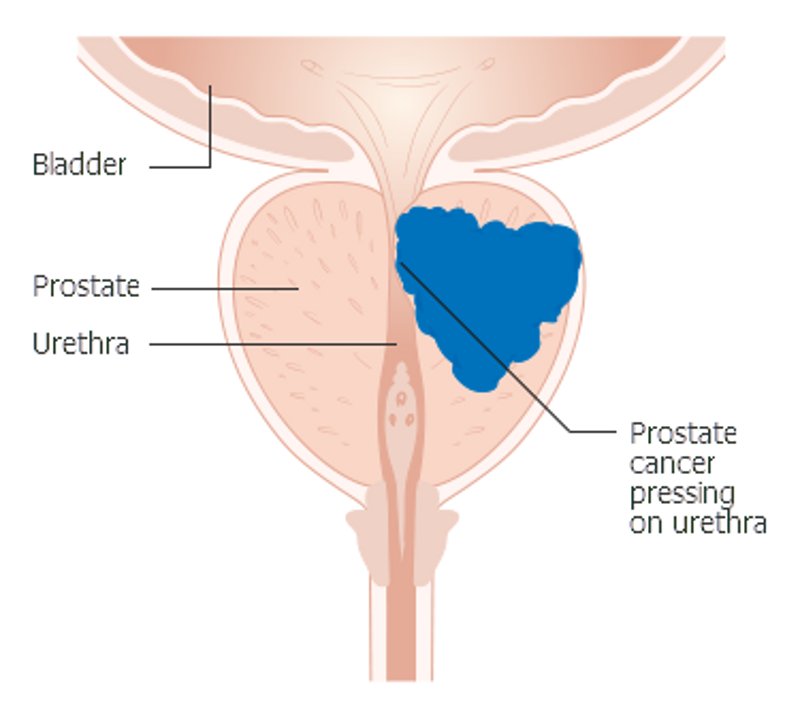
By Cancer Research UK (Original email from CRUK) [CC BY-SA 4.0], via Wikimedia Commons
Contents
I. What is Prostate Cancer?
Prostate cancer is a medical condition that affects the prostate gland. Because only males have prostate glands, it also goes that the condition only affects men.
The condition starts in the gland cells. As with other types of cancer, this is classified into different stages, depending on the sizes of the tumors, progress of the condition, and how far the tumors have spread.
II. Prognosis
What makes prostate cancer somewhat different from other forms of cancer is that it has a rather slow progress.
In fact, according to Medical News Today, a lot of those who have prostate cancer do not even know they have the condition and later die of old age. It is only when autopsy is done to determine the actual cause of death that the cancer is detected.
Doctors have recently made a rough estimate, claiming that nearly 50% of men over the age of 50 actually have Prostatic intraepithelial neoplasia (PIN) or the so-called first stages of prostate cancer. In this condition, the cancer cells are present but they remain in the prostate gland.
But there are always exceptions to the rule. There have been a number of reported cases of aggressive types of prostate cancer. In such cases, the cancer cells spread quickly and could lead to death if not treated soon enough.
Still, the overall prognosis for prostate cancer is good.
III. Causes
According to Mayo Clinic, doctors still have not found the actual cause of prostate cancer but have already established that this condition starts when cells within the prostate gland have become abnormal. The mutations in the cell’s DNA cause it to grow and divide rapidly, faster than normal cells would.
While other cells die off, the abnormal cells live on and develop into a tumor. These abnormal cells can invade nearby tissues and could even spread to other parts of the body.
IV. Risk Factors
a. Age
Age is the primary risk factor for this condition, especially because most of those diagnosed with prostate cancer are over 50 years old.
b. STDs
In a research done by the University of Michigan Health System, men who have had gonorrhoea are more likely to develop prostate cancer.
c. Genetics
Based on a number of studies, it has been shown that genetics plays a huge role in determining whether you will develop prostate cancer or not. For example, the condition is more common and more deadly in African Americans than Caucasians, according to Medical News Today.
V. Symptoms
As with other types of cancer, there were no early warning signs of the early stages of prostate cancer. But as the tumor grows, it affects the prostate gland and lead to the following symptoms:
- Weak or interrupted urinary system
- Frequent urination, especially at night
- Painful sensation during urination and/or ejaculation
- Loss of control of urinary system
- Blood in the semen and/or urine
Web MD reveals that these symptoms are not actually due to the cancer itself but by the blockage caused by the tumor. As the condition progresses, the patient could experience the following:
- Vomiting and nausea
- Loss of appetite
- Fatigue
- Swelling of the lower extremities
- Constipation
- Paralysis or weakness of the lower limbs
- Dull pain in the upper thighs, pelvis, and lower back
VI. Diagnosis
Doctors might tell older men to undergo tests to check whether they have normal prostate gland function and to rule out the possibility of cancer. According to Mayo Clinic, tests could include the following:
a. Prostate-specific antigen (PSA) test
The prostate gland produces PSA. While it is found in the blood under normal conditions, large quantities of PSA could be present if the person has prostate cancer.
So, one way to test for the condition is to check the levels of PSA in the blood.
b. Digital rectal exam (DRE)
The doctor inserts a gloved, lubricated finger inside the rectum to check the size, shape, and texture of the prostate gland. This is among the basic options for diagnosing the condition as the gland is located next to the rectum.
c. Ultrasound
According to Mayo Clinic, the doctor might order an ultrasound if abnormalities were found in the PSA test or DRE. A probe is inserted inside the rectum. This produces sound waves that aid the doctor in taking a ‘picture’ of your prostate gland.
d. Prostate Biopsy
After the initial tests suggest that the patient has prostate cancer, the doctor often orders a biopsy. A thin needle is inserted into the prostate gland to collect samples. The biopsy will determine whether the tumor is benign or malignant.
e. Gleason Scoring
Once the prostate cancer is established, its aggressiveness is determined, often using Gleason Score.
f. Other Tests
To check whether the cancer cells have spread to other parts of the body, the doctor might order further tests. Such tests include the following: Ultrasound, Bone scan, Magnetic resonance imaging (MRI), Positron emission tomography (PET) scan, Computerized tomography (CT) scan.
While the prospect of undergoing all these tests seems daunting, patients are not required to under all these diagnostic examinations. Many only undergo DRE and ultrasound. Biopsy may be done after the tumor is removed.
VII. Treatment
Web MD reveals that there are a number of ways that the patient can be cured of prostate cancer, especially if the condition was diagnosed at its early stages.
Some options include the following:
a. Laparoscopic Surgery
In this minimally invasive surgery, cameras/scopes are used to aid in the removal of the tumors.
b. Radial Prostatectomy
This surgery involves the removal of the prostate gland and surrounding tissues.
c. Hormone Therapy
Hormones may be used to treat prostate cancer. This type of treatment is sometimes called as androgen suppression therapy.
d. Radiation Therapy
High doses of radiation may be used to destroy the cancer cells affecting the prostate gland, just like in other types of cancer.
e. Cryotherapy
While radiation therapy makes use of heat, cryotherapy freezes the cancer cells in an attempt to destroy them.
VIII. Prevention
Good news for sexually active men: according to Harvard Prostate Knowledge, significant research studies have shown that frequent ejaculation, by any means, seems to protect men from prostate cancer.
But this is not the only way that prostate cancer can be prevented. A healthy diet, exercise, and rest are also known to help keep the body in shape and healthy enough to prevent cancer as well as other medical conditions and diseases.





